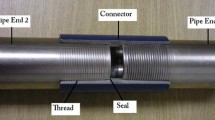Abstract
Friction loss characteristics of fire hose have changed as a result of evolving hose manufacturing technology. Published friction loss characteristics may be overly conservative. While conservatism in fire protection is generally good, in this case it may lead to excessively high pump discharge pressures as the operator applies general rules-of-thumb. The overall objective of this research project was to develop friction loss characteristics for hose currently used by the fire service. A total of 86 tests were performed by three fire service organizations on 82 fire hose samples spanning 1–5 inches in diameter. Recorded hose dimensions, pressure, flow and friction loss data were used to calculate the friction factors. Three friction factors were calculated: C, the factor now used in published data; and, CD and f. The traditional C factor combines hose diameter and roughness into a single constant. The CD and f factors use the measured diameter to calculate a friction factor closely associated with hose interior roughness. The data indicate that most C factors calculated for the tested hose fall below the currently published values. The CD and f factors provide more insight into friction loss characteristics, since the effects of actual inside diameter are considered. Overall, the friction loss characteristics observed for individual tested hose sections are a factor of the inside diameter and roughness. Inside diameter alone was not a predictor of the magnitude of the friction loss across all samples. A fairly large degree of variability was observed in the data.




Similar content being viewed by others
References
Gaskill JR (1966) Hydraulic studies of fire hose. Fire Technol 2(1): 37–51.
Gaskill JR, Henderson RL, Purington RG (1967) Further hydraulic studies of fire hose. Fire Technol 3(2): 105–114.
Thorne PF, Theobald CR, Mahendran P (1975) Pressure loss in UK Fire Hose, Fire Research Note, No. 1036.
NFPA 1961 (2007) Standard on fire hose. National Fire Protection Association, Quincy.
NFPA 1002 (2009) Standard for fire apparatus driver/operator professional qualifications. National Fire Protection Association, Quincy
Haston DV, McKenzie DW (2006) Friction loss in wildland hose lays. United States Department of Agriculture Forest Service, San Dimas.
Roberson JA, Crowe CT (1976) Engineering Fluid Mechanics, 2nd edn. Houghton Mifflin Company, Boston.
Wieder MA (2008) “Fire Streams,” Section 13, Chapter 3, NFPA Fire Protection Handbook, 20th edn. Quincy.
International Fire Service Training Association (2006) Pumping apparatus driver/operator handbook, 2nd Edition, Oklahoma State University, Stillwater.
Wieder MA, Michael A (2005) “Fire Service Hydraulics. Oklahoma State University, Stillwater.
Scheffey JL, Forssell EW, Benfer ME (2012) Determination of fire hose friction loss characteristics, prepared for The Fire Protection Research Foundation, Quincy.
Linder KW (2008) Hydraulics for Fire Protection, Section 15, Chapter 3, NFPA Fire Protection Handbook, 20th edn., Quincy.
Acknowledgments
The authors would like to extend their gratitude to Mark Salafia of the Connecticut Fire Academy; Mike Gallagher of the Middlesex County Fire Academy; Ron Peddy and Jim Hall of the Texas Engineering Extension Services; and Jim Cottrell, for donating measurement equipment and organizing the shipment of the equipment to and from the fire service facilities. These gentlemen, along with their staff, provided hundreds of man-hours to coordinate and conduct the flow tests. The hose manufacturers, including All American/Snaptite, Angus/UTC, Mercedes, Key Fire Hose, Neidner, and North American contributed hose samples. This project could not have been performed without their contributions. Kochek Co., Inc. and Task Force Tips also contributed equipment for the testing.
Author information
Authors and Affiliations
Corresponding author
Electronic supplementary material
Below is the link to the electronic supplementary material.
Rights and permissions
About this article
Cite this article
Benfer, M.E., Forssell, E. & Scheffey, J. Determination of Fire Hose Friction Loss Characteristics. Fire Technol 53, 1059–1075 (2017). https://doi.org/10.1007/s10694-016-0617-z
Received:
Accepted:
Published:
Issue Date:
DOI: https://doi.org/10.1007/s10694-016-0617-z




